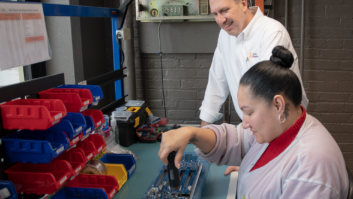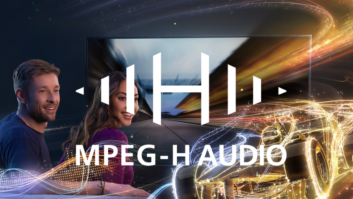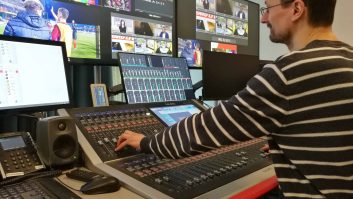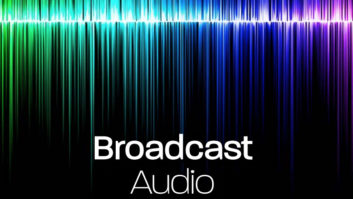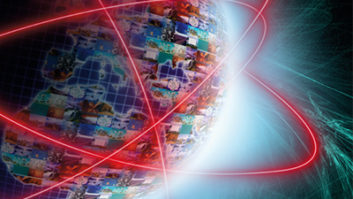The integrally important world of audio development and innovation for broadcast use has arguably lived in the shadow of progress in visual technologies in the media marketplace for some time, but the importance of the work being done in this area is not lost on the industry.
Discussing the latest developments and future opportunities are Chris Pike, lead R&D engineer, BBC Research & Development (Immersive and Interactive Content section); Dave Letson, VP of sales, Calrec; and Brad Price, senior product marketing manager, Audinate
Prior to the pandemic, what technologies or trends would you say were having the most enabling impact in your area of expertise?
Chris Pike (CP): The rapid development and commoditisation of machine learning and augmented reality technology in mobile platforms enables interesting new possibilities. We can bring our services and stories into the audience’s own environment and hopefully ways to make information and entertainment more engaging and enjoyable.
Personally, I have been excited about the growth of smart audio headsets, with features like active noise cancellation, motion tracking, and voice control. With these capabilities and other tools like spatial audio and object-based media, we can explore auditory augmentation of the listener’s environment and adaptive storytelling experiences.
Thinking closer to current services, next generation audio codecs could soon allow us to deliver object-based media benefits to TV services, including personalisation of the mix to improve intelligibility and delivery of immersive 3D audio. In the last couple of years, this technology has become more widely available in broadcast and consumer technology, and it could soon be feasible to deliver these benefits to audiences.
Dave Letson (DL): Prior to the pandemic, the move from proprietary to IP networks was the biggest shift in thinking and was having the most enabling impact, and will continue to have post-Covid. There’s no doubt that the ability to link up with third-party IP equipment over SMPTE 2010-30 is bringing broadcast communities together. Right now, most broadcasters still use proprietary systems and many aren’t ready to jump headlong into a full IP infrastructure. Manufacturers like Calrec support this with AoIP bridging interfaces to enable its Hydra2 equipment to talk to third-party IP equipment, as well as a range of full IP equipment so broadcasters can stay proprietary, switch to IP or do a combination of both.
Brad Price (BP): The biggest impact was the continuing growth of AV-over-IP within the broadcast space. For Audinate, this was specifically seen in adoption of Dante by broadcasters looking to transmit audio signals over their networks. Because Dante is interoperable with AES67 and SMPTE 2110, broadcasters found multiple ways to use Dante to make production workflows more efficient and high quality. Of course, prior to the pandemic, Audinate announced the addition of the video layer to Dante with Dante AV. That was a move based on demand from a number of markets, including broadcast. Those AV solutions are just coming to market now, but we expect that demand to transfer video as easily as you can transfer audio over networks to continue well into the future.
Again pre-pandemic, what were the biggest areas of challenge in terms of technology development or deployment in your field?
DL: Most of the technology we’ve been working on as an industry for the last few years has been creating the equivalent of a BNC or XLR cable for getting signals over a network; the advent of IP networks. As more broadcasters look to adopt this technology there is more work to be done in discovery and connection management, and in connectivity over longer distances. NMOS support is vital for discovery/advertisement (IS-04) and for connection management (IS-05). It means users don’t have to log in to devices on a network to configure connections but use a single interface capable of routing streams between devices from different manufacturers.
BP: The ongoing challenge is to continue converting broadcasters still using analogue and point-to-point signals onto networked workflows. That said, as we enter the new year the pushback we had previously seen to AV-over-IP adoption is rapidly diminishing. People are seeing the benefits of AV-over-IP – the ease-of-use, the cost reduction, the improved management capabilities – clearly outweighing the desire to remain with traditional cabling. We’ve also seen more broadcasters using Dante AVIO adapters to bring legacy audio gear onto the network, which saves money and brings many of the benefits of networking to earlier equipment.
CP: For next generation audio, the challenge is transforming the end-to-end broadcast chain. To introduce personalised and immersive audio would require new formats and techniques in production, new codecs for delivery, and new features in audience devices. The challenge is not just technical, it would require changes to workflows and developing new skills. There are technical challenges to overcome still, which require work in standards and industry bodies, and close collaboration with industry partners.
When looking at virtual and augmented reality, a key challenge is around adoption. We have a lot of experience now in making VR and we know it can be amazing, but right now there’s still a relatively small audience with suitable devices. Mobile AR has a much broader reach but doesn’t offer the same levels of immersion. As headset technology improves and becomes cheaper, uptake may well increase, but it also relies on there being experiences and content available that give value to people. Our role is to explore and test the value of what the public service media can offer to people on these platforms.
What effect (if any) has the pandemic period had on your area of the market in terms of accelerated technology adoption/deployment, or any other significant areas?
BP: We’ve seen a steady increase in the number of broadcasters migrating to AV-over-IP for day-to-day work during the pandemic. Networked gear has allowed people to work easily at increased distances on-premises and it works incredibly well, with no latency, analogue noise or hum. AV-over-IP also enables at-home set-ups where a single network cable can be run out of a home to a broadcast truck. Sophisticated users employ networking to connect in-home AV-over-IP set-ups to control rooms miles away, with no diminishment of quality. Audinate tools such as Dante Controller and Dante Domain Manager enable remote troubleshooting in broadcast environments: if a technical staffer is called about an audio issue, they may be able to troubleshoot from their home with these softwares – and without the need to go into a studio where social distancing needs to be in effect.
CP: The most noticeable effect in spring of 2020 was that several big companies scaled back their work on immersive augmented reality. However, I don’t see that as the end of AR by any means, it appears more likely to be market changes due to an economic shock. If anything, the future of immersive media systems has been strengthened by the pandemic, particularly considering social interaction. Videoconferencing tools have been so useful in our work and social lives this year, but things can be better.
In terms of our work at the BBC, the pandemic has encouraged our exploration of synchronised media experiences, especially when people who are apart want to experience something together. Our work on media device orchestration allowed us to quickly develop and launch the BBC Together pilot in response to lockdown, allowing people to watch or listen to BBC programmes with family and friends at the same time while being apart. I see ideas like that growing in importance as our internet and mobile networks advance.
DL: Definitely remote workflows. At first remote working was through necessity in order to keep on air while adhering to safety guidelines, but as an industry we’ve all been developing more sophisticated methods of remote working all year; so much so that the distinction between remote working and remote production has been blurred. From an audio perspective, remote production is capturing audio at the venue to create no-latency IFB mixes and mixing this back at base. Remote working has a mixer at home, some distance from the processing core using a GUI like Calrec Assist or some hardware; the core could be in a studio, or it could even be in an OB truck. We had one customer mixing at home connected to a core in a production studio remotely mixing at a venue!
What would you say are the technologies or trends that are going to have the most profound impact in your field in the coming years, and why?
DL: Remote working has gone beyond safety and is more about efficiency. From a production perspective it’s more efficient to mix in a secure, dedicated room where the processing core is located, and remote into multiple venues rather than send OB trucks to each location. Instead, we can have a small team of people at multiple sites and mix them all from the same control room. We’ve been working with other customers, like PRG in the US, on other distributed production team models where a Calrec Artemis surface in LA controls an Artemis core in Tulsa over IP. The combination of the continued development of IP and more flexible working environments is very exciting.
CP: I think that when immersive AR headsets reach the critical point of being affordable, lightweight and of high quality, it will completely transform the role of digital technology in our lives. We will move from peering at small flat screens to things being completely integrated into the world around us. That might sound scary and dystopian to some, and we’re likely years away from that yet. However, things are moving rapidly. We want to ensure that when these technologies arrive, we understand how to use them to deliver valuable services and experiences, building on the role that public service media has in society on current platforms.
BP: The long trend towards all-digital AV networking is inescapable, and this transition will continue apace for years to come. Audio has long been a solved problem for networked solutions, and video is now following the same trend line. The dream of ‘one port for everything’ is very much alive and well, and will continue to be the AV story in the future.
